A Place to Thrive
By Douglass K. Daniel
Photographs by Walter Calahan
Earning the Hornaday Silver Medal, Scouting’s top conservation award, shaped Eagle Scout Joshua Stone as much as he reshaped the environment.
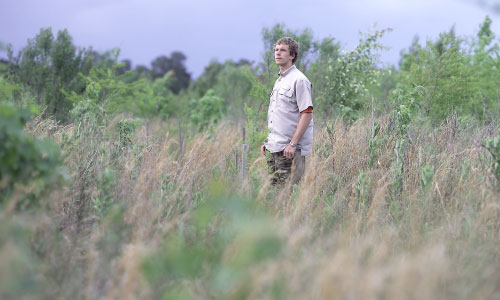 Josh looks across the Blackwater National Wildlife Refuge, site of his conservation projects. |
Joshua Stone tilts back his head as his eyes scan the height of a sycamore tree towering 18 feet tall. Other young sycamores surround him, with upstart sawtooth and northern red oaks and green ash at their sides.
“They’re doing really well,” says Josh, his tone like that of a proud father as he surveys the trees he helped plant. “They wouldn’t grow on their own here. We’ve definitely helped with that.”
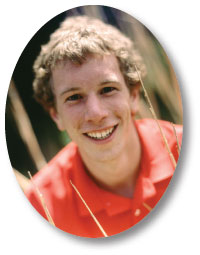 Five years earlier, this was an unremarkable patch of grass within the Wye Island Natural Resources Management Area on Maryland’s Eastern Shore. Today it is a stand of trees that staves off erosion and offers birds and other small wildlife a place to thrive.
Five years earlier, this was an unremarkable patch of grass within the Wye Island Natural Resources Management Area on Maryland’s Eastern Shore. Today it is a stand of trees that staves off erosion and offers birds and other small wildlife a place to thrive.
Josh Stone has grown, too. Like the trees, he is taller — and has developed stronger, deeper roots with the environment.
For his work on Wye Island and three other projects on the Eastern Shore, the BSA awarded Josh the William T. Hornaday Silver Medal for distinguished service to natural resource conservation and improvement. It is Scouting’s highest honor for environmental stewardship.
“What you’ve accomplished is truly significant,” U.S. Interior Secretary Dirk Kempthorne told Josh during a ceremony earlier this year in Washington, D.C. “We’re extremely proud of you and salute your commitment to leaving our country an even better land than you found it.”
His own backyard
Josh didn’t have to go far from home to find wild places worth saving. He and his family live on the Eastern Shore, a peninsula on the eastern side of the Chesapeake Bay that is next to the Atlantic Ocean at the southern end of Maryland.
He grew up in Royal Oak, Md., and joined Troop 741 in nearby St. Michaels, part of the BSA’s Del-Mar-Va Council. His interest in the natural world was fostered in part by his father, Roger Stone, a government biologist now with the Blackwater National Wildlife Refuge.
Home-schooled like sisters Skyla and Clara by his mother, Kathy Stone, Josh took some of his science lessons from his dad. And, as a Scout, he enjoyed the outdoors with frequent hikes and camping trips.
The Hornaday Award encourage and challenge Scouts like Josh who want to have a positive impact on the environment. Earning the Silver Medal requires significant projects in at least four different categories of conservation — no easy feat and one that can take years to complete.
A bridge for the woods
Josh’s work toward the Hornaday Silver Medal began in late 2000 when he was just shy of 13 — not that the top award was his goal at the time. As part of his conservation work in Scouting, he wanted to start a project that helped reverse the shrinking forest areas in the Blackwater refuge near his hometown.
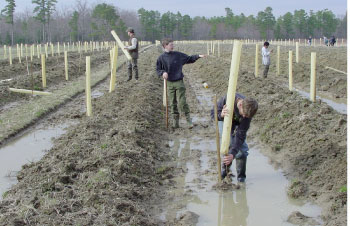 Josh directs fellow Troop 741 Boy Scouts in placing protective tree tubes over nearly 2,000 seedlings in the Blackwater National Wildlife Refuge. |
When large tracts of forest are divided into smaller parcels, with treeless gaps in between, plants and animals are less likely to use them for habitat. Many species of birds, for example, will not fly over land barren of trees.
A forester with the U.S. Fish and Wildlife Service, Tom Eagle, helped Josh develop a plan to bridge the gaps between forests. In March 2001, two dozen volunteers, most of them Scouts from Troop 741, spent a weekend planting 2,000 trees donated by the National Tree Trust. Local organizations helped buy plastic tree tubes, which served as a greenhouse and protected the seedlings from deer.
When Josh and Tom Eagle returned that summer with Bill Reybold, Josh’s Hornaday Award adviser, they found nearly seven of every 10 trees alive and well—a good survival rate. Some were already growing taller than the tops of their four-foot tubes. The project’s success and the long-term impact it promised for Blackwater excited Josh.
“Preservation of the environment is something I want to work for the rest of my life,” Josh says.
Shoring up the shoreline
Josh’s next undertaking, which also served as his Eagle Scout service project, provided a different challenge. Working with Maryland Department of Natural Resources Ranger Dave Davis, Josh decided that a project to thwart erosion would best benefit the Wye Island Natural Resources Management Area.
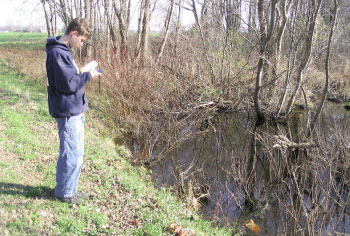 Josh collects water samples from a stream in Dorchester County, Md. |
One of the numerous tidal creeks on the Eastern Shore was eating away at a stretch of island shoreline.
Over time, mighty trees, their roots weakened by loss of soil, would slowly tilt and eventually tumble to the ground.
Josh’s plan called for planting 1,000 seedlings to create a strip of sycamores and other trees between a farm field and the tidal creek. Besides being a refuge for wildlife, the buffer would help hold soil and keep nutrients used in farming from flowing into the Chesapeake Bay.
Beyond the tree stand, Josh would plant marsh grasses along 1,500 feet of shoreline. Their root mass would hold the soil as well as provide habitat for minnows, fiddler crabs, and other aquatic life in the area.
Josh developed a budget and submitted a grant application for more than $5,000 to the Chesapeake Bay Trust, which approved the project and supplied the funds.
A Hornaday project is practical as well as educational. “I learned a lot about…writing grants, getting people together, things like that,” Josh said.
Josh prepared the shoreline by clearing it of wood and other debris in February 2002, again enlisting his Scout troop and other volunteers. Two months later they returned to plant the trees and marsh grasses.
Mapping a plan of attack
Invasive plants were slowly but surely overtaking the Jean Ellen duPoint Shehan Audubon Sanctuary, a 950-acre peninsula on the Eastern Shore. Its managers needed a plan to eradicate, or at least control, the unwanted species. This led to Josh’s third conservation project.
With the guidance of sanctuary project coordinator Amy Bourque, Josh set out to map the peninsula’s invasive plants. That would provide a baseline to monitor their progression and a first step toward wiping them out.
Using Global Positioning System technology and computer mapping software, Josh and a team of volunteers found:
- Japanese honeysuckle, which can suffocate trees and ground vegetation with its vines.
- Phragmites—the common reed—which can overtake native marsh grasses.
- And the thorny shrub called multiflora rose.
All these plants were invasive, all problematic for the sanctuary, and now they were all on Josh’s map.
Out of the woods, into the lab
One more project remained. And it took more time than any of the others.
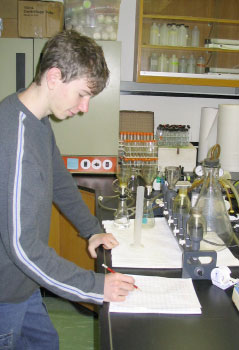 In the lab, Josh analyzes the samples to determine if land cover affects the amount of nutrient runoff into Chesapeake Bay. |
In 2004 Josh began analyzing the relationship between land cover and water quality. After training with Tom Fisher, a professor at the Horn Point Laboratory of the University of Maryland Center for Environmental Science, he began drawing water samples in Dorchester County, Md., and then analyzing them in the Horn Point lab.
His research question was simple: Does land cover significantly affect the amount of nutrient runoff into the Chesapeake Bay? To find the answer, Josh collected water samples from 10 different streams on 21 occasions. Each sample took nearly four hours to collect; each analysis took 10 hours more to complete.
His initial 24-page study confirmed that when developed land and agricultural fields are located within a watershed, increased concentrations of nutrient and suspended solids pollution occur.
The study was timely, because the local community was debating whether to allow a housing and shopping center development to be built in the area. Josh’s findings became part of the discussion.
“That opened my eyes to how these kinds of projects could affect the real world and different environmental issues. It wasn’t just planting trees,” he says.
Josh continued to collect samples and plans to submit a research paper on the project to a scientific journal.
A proud moment at last
All these projects took time—and Josh had an active life in addition to Scouting. There were karate classes and his work with Young Life, a nondenominational Christian ministry. He also attended Chesapeake College in his final years of high school.
 U.S. Interior Secretary Dirk Kempthorne presents Josh the William T. Hornaday Silver Medal during ceremonies last January in Washington, D.C. |
When Josh’s enthusiasm for earning the Hornaday Award waned, his adviser, Bill Reybold, pushed him to stay on track and complete all the requirements and paperwork.
And he did. One month before his 18th birthday, Josh submitted his application for the Hornaday Silver Medal. A year later, his family, mentors, and friends applauded at the Interior Department in Washington, D.C., as Secretary Kempthorne pinned the silver medal to Josh’s uniform.
A humbling experience
Today, Josh is looking forward to completing his second year as a biology and Spanish major at Messiah College in Grantham, Pa. He sees enormous potential for biologists in Central and South America.
Earning the Hornaday Silver Medal has helped him take big strides toward his next goal: a doctorate in a biological field.
“It’s given me a head start,” he says. “The whole scientific process of publishing a paper and doing an actual research project is something most science majors don’t get to do until they get to grad school.”
Josh returns occasionally to Wye Island, Blackwater, and the Audubon sanctuary. He likes to see how his work has changed these wild places — and he remembers how they changed him.
“I didn’t fully realize how much of an impact I could have. The things I do now can really affect the future,” he says. “It’s humbling in a way — that I can have that much impact on the world around me.”
Douglass K. Daniel is an editor for the Washington, D.C., bureau of The Associated Press.
ON THE WEB: To read of another Boy Scout conservation effort, go to scoutingmagazine.org/, click on Archive/Back Issues, then Articles, then Nov.-Dec. 2005, for “Planting the Seeds for a Legacy of Service.”
The Hornaday Awards: ‘Unusual Prizes for Unusual ServicesHow rare is the William T. Hornaday Silver Medal? The William T. Hornaday Awards—seven honors in all—commemorate the singular dedication of one of America’s top conservationists. William Temple Hornaday (1854-1937) successfully pushed for laws limiting the hunting of migratory fowl, and he is credited with saving the American bison from extinction. He laid the groundwork for the National Zoo in Washington, D.C., and spent nearly 30 years as director of the world-renowned Bronx Zoo in New York. The awards began in 1914 for Scouts who completed outstanding conservation projects, and they were later renamed in honor of Hornaday following his death.
For individual Boy Scouts, Varsity Scouts, and Venturers, the program offers three honors tied to specified merit badges and significant projects in natural resource conservation. Applications for Hornaday Awards must include detailed project reports and other supporting documents. The BSA recommends that those working toward the silver medal plan on at least two years to complete the requirements. Most Scouts take longer. The biggest reason so few Scouts earn the bronze and silver medals may be for lack of knowing about them, says Frank Reigelman, the BSA’s director of camping and conservation and a Hornaday Awards Committee adviser. “We need to make sure those boys and young adults who may have the initiative to pursue these awards know about the program,” Reigelman says. “Beyond that, it takes a special individual who has a strong desire to do the required projects.” As William T. Hornaday himself once said, “Unusual prizes are to be won only by unusual services.” For complete information about the Hornaday Awards, go to: www.scouting.org/awards/hornaday. —D.K.D. |
2008 Philmont Trail Crew TrekPhilmont’s Trail Crew Trek (TCT) is designed for Boy Scouts and Venturers who are passionate about the environment and committed to stewardship of our natural world. The TCT is a 14-day hike in Philmont’s backcountry that emphasizes earning the BSA’s William T. Hornaday Silver Medal when the participants return home. During the trek, participants will learn about:
Four TCT sessions will be offered in 2008 for Scouts and Venturers who are least 16 years old, physically fit, and highly motivated to earn the Hornaday Silver Medal. For more information, write: Trail Crew Trek, Philmont Scout Ranch, 17 Deer Run Road, Cimarron, NM 87714. |
October 2007 Table of Contents
Copyright © 2007 by the Boy Scouts of America. All rights thereunder reserved; anything appearing in Scouting magazine or on its Web site may not be reprinted either wholly or in part without written permission. Because of freedom given authors, opinions may not reflect official concurrence.
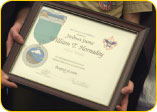 Last year, more than 51,000 boys earned the Eagle Scout rank. In the last five years the number of Scouts who earned the Hornaday Silver Medal totaled just 12. The Bronze Medal went to 19.
Last year, more than 51,000 boys earned the Eagle Scout rank. In the last five years the number of Scouts who earned the Hornaday Silver Medal totaled just 12. The Bronze Medal went to 19.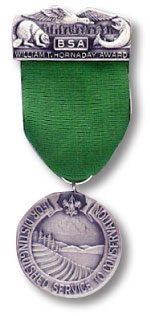 Two Hornaday Awards, a gold badge and a gold medal, are for adults. A gold certificate honors a corporation or organization. A unit award honors a pack, troop, team, or crew for its conservation project.
Two Hornaday Awards, a gold badge and a gold medal, are for adults. A gold certificate honors a corporation or organization. A unit award honors a pack, troop, team, or crew for its conservation project.